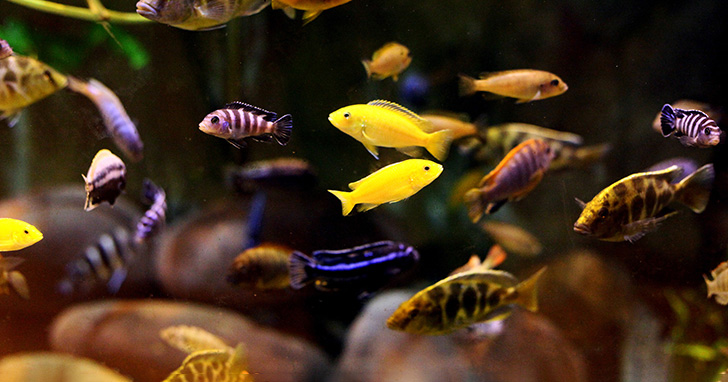
A Closer Look at a Mixed African Cichlid AquariumEstablished in February 2002, this 155 gallon, all glass, bow front African Cichlid aquarium is just one of many marine and freshwater aquariums designed and maintained by the LiveAquaria® Aquatic Services staff. In addition to affording our own aquatic staff the opportunity to apply and advance their knowledge of the hobby, these are the aquariums where we put new products to the test before offering them to our customers. We invite you to take a closer look at this beautiful aquarium display dedicated to African Cichlids. What fish should I add to a Cichlid tank? Primary Population
All Cichlids were added simultaneously as juveniles to an established aquarium.
Several Cichlids have since paired off and bred, increasing the original population. Diet
African Cichlids should be fed a variety of both meaty and vegetable based foods. Feed live and frozen brine shrimp along with Spirulina-based flake and pellet foods. Feeding the Bushy Nose Plecostomus is not difficult due to the fact that it is not a fussy eater. Feeding off the bottom of the aquarium, it gets most of its nutrition from leftover food and algae. If there is no algae or leftover food present, supplement with high quality flake foods, algae wafers and other high quality plant based foods. The Synodontis decorus Catfish is an omnivore that should be offered sinking catfish pellets, freeze-dried bloodworms and tubifex, as well as a quality flake food. For best care, feed the Clown Loach small meals several times throughout the day. Younger Clown Loaches will eat most prepared foods while older ones may be more finicky. Prepared foods such as vegetable flakes or tablets along with meaty supplements such as live, frozen, or freeze-dried worms will provide this species with the proper nutrition. Feeding times: Daily, between 9-10 a.m. and 4-5 p.m. What décor is needed for Cichlid tanks?
To best fulfill the needs of these beautiful, intelligent, and territorial fish, we designed the caves and nooks to create a healthy, secure African lake biotope. 20 flat and approximately 20 variously shaped stones (3"-6" in diameter) were used in constructing the numerous caves/shelter areas, and medium/large multi-colored gravel was spread 2"-3" deep throughout the aquarium floor. What are the water requirements for Cichlid tanks?
Water, treated by reverse osmosis with R/O Right powder, was added to re-mineralize the water and buffers were added to adjust alkalinity and pH. Additives and/or water supplements are to be used after a water change or when pH drops to maintain water parameters suitable for Cichlid health. Water testing was conducted with Aquarium Pharmaceuticals Master Test Kit (tests for pH, high-range pH, ammonia, nitrite, and hardness). African Cichlids prefer higher pH, dH, and temperatures than other freshwater fish. Parameters of the African Cichlid aquarium should include:
What supplies do I need for a Cichlid tank?
What maintenance is required with Cichlid tanks?
Daily:
Weekly:
Bi-Weekly:
Monthly:
Related Articles
|
|
|




